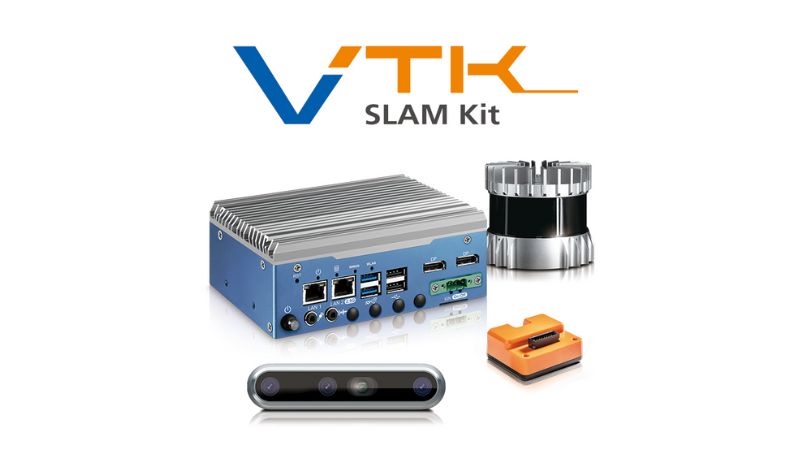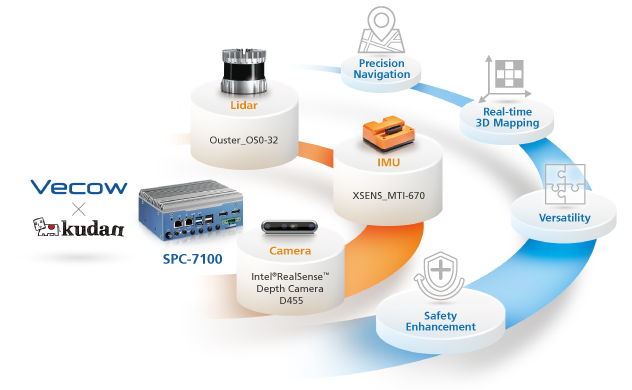Vecow and Kudan Advance Mobile Robotics and Inspection with SLAM and Edge AI
Vecow announced its VTK SLAM Kit, leveraging Kudan’s simultaneous localization and mapping technology to promote industrial mobile robotics and inspection applications.
Vecow Co., Ltd. has entered a strategic partnership with Kudan Inc. to deliver an integrative hardware and software solution for advancing autonomous perception, navigation, and mapping in autonomous mobile robots. The partnership combines Vecow’s embedded computing knowledge in Edge artificial intelligence applications and Kudan’s simultaneous localization and mapping (SLAM) tech. Vecow also announced the release of its Edge AI computing system for cross-industry use in applications such as autonomous mobile robots (AMRs), traffic vision, and optical inspection.

The VTK SLAM Kit combines edge AI and SLAM technology to promote autonomous navigation and mapping in AMRs and other autonomous guided vehicles in unmapped environments. Image used courtesy of Vecow
Improving Operational Efficiency
Automated systems rely on effective communication networks to send and receive data, analyze that data, and act through purposefully curated algorithms. Without effective communication, time delays and process disruptions can stall production in manufacturing facilities or delay product shipping in warehouse and logistics centers.
Businesses are looking to edge computing capabilities to reduce latency and enhance data processing for improved operational efficiency across industrial processes. Let’s explore AMRs and how this application area can benefit from Vecow’s Edge AI Computing know-how and Kudan’s SLAM software expertise.
Enhancing AMRs for Faster Time-to-market
The VTK SLAM Kit incorporates 3D-LiDAR-based SLAM software to help mobile robots sense objects in their environment via pulsed light wave-based sensing. By using the real-time spatial data provided by multiple sensors, an AMR can modify its position appropriately to avoid obstacles and select the most efficient path. Both autonomous guided vehicles and AMRs with SLAM-based self-localization use a generated map of their environment to move autonomously, delivering goods in the fastest way possible while dodging people, other vehicles, and other obstructions such as spillages to deliver or pick up goods and materials within flexible automotive assembly lines and warehouse and logistics centers.

A graphic depicting the integrated hardware components and output capabilities of the VTK SLAM Kit for surveillance, traffic vision, and factor automation applications. Image used courtesy of Vecow
The VTK SLAM Kit integrates wheel odometry, which helps measure the distance a robot has traveled based on wheel rotation. This odometry, coupled with an inertial measurement unit, provides AMRs and other autonomous vehicles with optimized balance and control when navigating their surroundings. Robots can respond dynamically to change, whether to move safely out of the way of an obstruction or a human worker.
By optimizing AMR perception with AI inference capabilities and real-time data, companies can maintain worker safety, increase delivery speeds of materials and goods (in manufacturing and warehouse settings), and achieve a faster time-to-market.
The EAC-4000 from Vecow’s EAC Arm-based Edge AI Computing range is another inter-process communication device focusing on providing customers with a small form factor for a great deal of computing punch with as much as 100 TOPS (Trillions or Tera Operations per Second) of AI performance. Vecow offers EAC-4000 models as 16GB, 8GB, and 4GB to accommodate AI-based applications with different requirements.
Vecow’s EAC-4000 Edge AI Computing System
The EAC-4000 offers in-band and out-of-band services for remote monitoring and managing edge devices, allowing users to reset processes or force shutdown.
An array of connectivity options (5G/4G/LTE/WiFi/BT/GPS/UMTS) offers real-time navigation, vehicle-to-everything communication, remote connectivity to conduct diagnostics, and in-vehicle hotspots to enhance customer security and convenience. Software ignition control assures optimal power management, and the control area network bus allows for robust inter-system dialogue, diagnostics, and control of critical automotive components.
In addition to in-vehicle computing, traffic control, and mobile robots, devices from the EAC Series accommodate robotic control, embedded AI, machine vision, advanced automated optical inspection (AOI), and smart video analytics applications.
With its processing power and rapid connectivity, the EAC-4000 can handle massive amounts of video stream data in real-time. Cordatus AI, an intelligent video analytics platform, processes video streams from many cameras to detect abnormalities, manage production lines, and assure security by applying AI algorithms to recognize objects and conduct behavior analyses.
The EAC-4000 performs AOI by processing high-resolution photographs to inspect products for flaws, ensuring compliance with quality standards and decreasing manual inspection efforts. Its architecture and interoperability with industrial cameras and sensors make it ideal for use in manufacturing contexts, delivering dependable and precise analysis to help optimize production operations.

 Facebook
Facebook Google
Google GitHub
GitHub Linkedin
Linkedin








